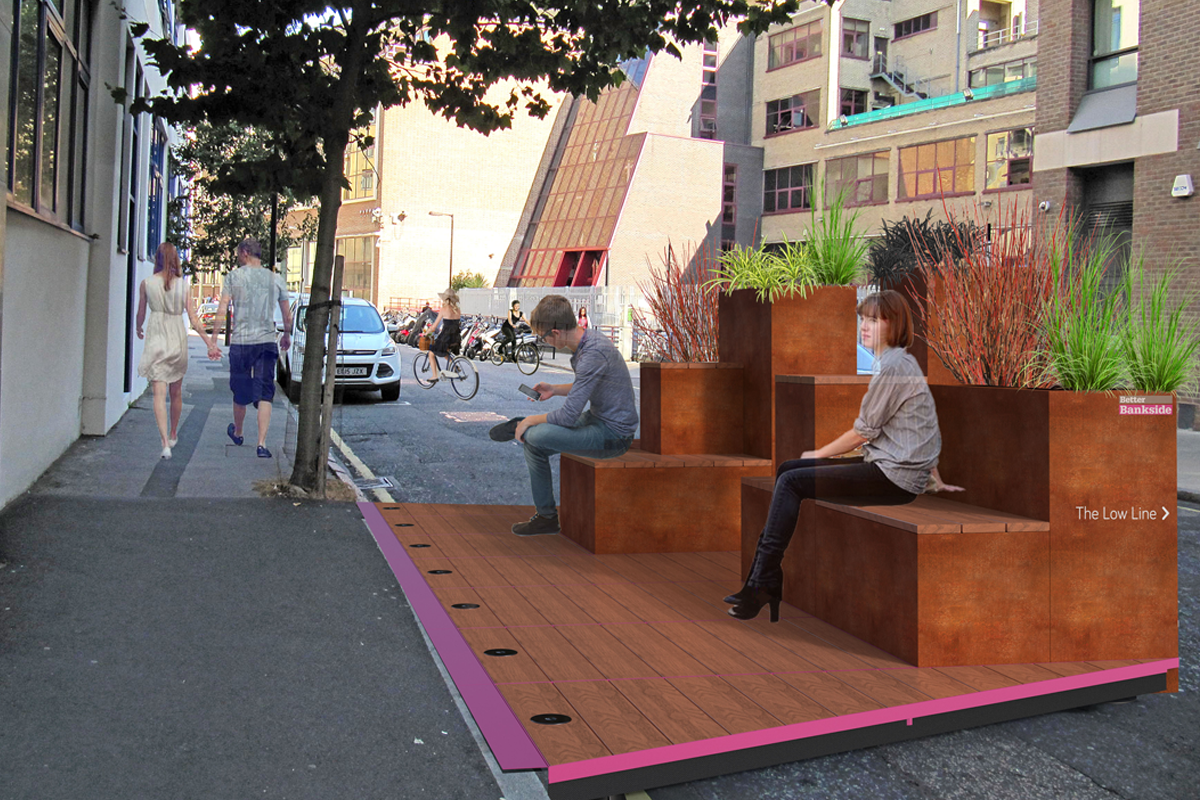Over the summer Cyclehoop and Witteveen+Bos joined forces to enter the Better Bankside design competition. The competition focused around a project that will trial a temporary reconfiguration of Lavington Street to a one-way street, and use the freed up road-space to extend the footpath at grade through the design of a new modular structure: Bankside Boardwalk, to help improve the quality of environment of Lavington Street for those on foot.
Witteveen+Bos, a leading Dutch engineering firm with a workforce of more than 1000 and a new office in London, approached Cyclehoop managing director Anthony Lau, with some initial ideas that were jointly developed by a team comprising a landscape architect and urban designer, into a final design.
Initially located on Lavington Street, the design had to help test how streets and pavements can be reconfigured to respond to the changing pressures that streets in cities and towns face, including accommodating increases in footfall and the need to navigate safely around building sites, temporary hoardings or roadworks.
The Cyclehoop and Witteveen+Bros design focused on creating a boardwalk for Walk, Play and Rest opportunities along the north side of the street. The typologies we identified along the street are:
1. Walk – where the pavement is narrow and needs widening
2. Play – where there is an opportunity for cycle parking and/ or where there is an opportunity for a business pop up (e.g. a coffee bar) and/ or vertical elements for climbing
3. Rest – where there is an opportunity for seating. All interventions will include modules for planting
The modular units are highly adaptable and can be locked together in different ways dependant on the identified typology of the location. Children will enjoy climbing and sitting on the unplanted structures, while the planted structures will bring architectural interest and colour to an otherwise grey street. Better Bankside has the opportunity to commission local artists to produce wayfinding and art to be installed to the rear and side faces of each modular structure to link with their Avenue of Art strategy.
Anthony Lau commented:
“It was great to work in collaboration with Witteveens+Bos on this competition. They came up with some exciting concepts for us to adapt into our modular units which we hope to develop further together”.
Witteveen+Bos project lead Rachael Cox said,
“As soon as we knew about this project, we knew that Cyclehoop would be our ideal partner as well-established, innovative designers of great cycle parking solutions and parklets. Their architectural and product design team, coupled with our urban design, landscape architecture and highways engineering team enabled us to design a sustainable, modular solution that would meet Better Bankside’s needs both on Lavington Street and subsequently elsewhere”.
Ten high-quality submissions were made from a total of 28 organisations representing a very wide range of disciplines from highways engineering to urban landscape design and product design. A panel made up of key partners Southwark Council and Transport for London were involved in selecting the winning team.
The competition was eventually won by SE1-based practice, Steer Davies Gleave, whom have been appointed by Better Bankside to develop design proposals for the Bankside Boardwalk project, which is funded in part through Transport for London’s Future Streets Incubator.
Bankside Boardwalk is commissioned as part of Bankside Urban Forest, the long term strategy to improve the network of streets and spaces in Bankside. Bankside Boardwalk will be installed in early 2017 after engagement with local businesses and residents, and will be on site for a six-month trial.
Streets account for 80% of London’s public realm, and as the number of residents, workers and visitors in Bankside increases, streets need to work harder to accommodate these differing needs. The Bankside Boardwalk will enable Better Bankside and its partners to test new ways of designing streets for the future.

